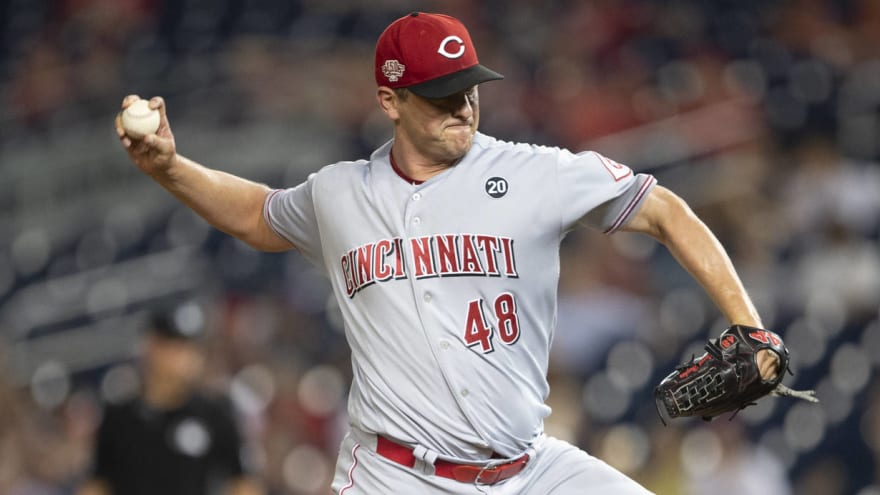
The signing of Jared Hughes might not have jumped off the front pages, but it might have been one of the more fascinating moves the Mets have made of late.
Hughes actually had some good years in Pittsburgh, Milwaukee, and Cincinnati. From 2014 to 2018, Hughes had a 2.41 ERA, 168 ERA+, and a 3.89 FIP over 329 innings pitched. He is a sinker ball pitcher who got a lot of ground balls but barely missed any bats.
Last season was a tough one for Hughes. His FIP ballooned to 5.29 and his HR/9 spiked up. That’s a pretty good sign that his sinker was not as effective and because he’s not a strikeout pitcher, he got hit hard and ended up getting waived at one point. Despite his struggles, he actually had some reasons to believe that he can bounce back. His sinker dropped 10.5 inches (the most in the MLB) and broke 1.5 inches. That was enough for him to be signed by the Astros but his 2020 much like everyone else’s, changed dramatically.
The pandemic cut spring training short and he opted out of his contract with the Houston Astros. Hughes wanted to use this time off to perfect his sinker and avoid the issues he had in 2019. Hughes’ journey was detailed in an article by Stephen J. Nesbitt of The Athletic.
Hughes used several resources to help him. One was a makeshift mound that he made in his backyard. Another was an inflatable catcher which he called Rod Barajas. He also enlisted the help of an aerospace engineer, Barton Smith. Smith was doing a tour of MLB teams during spring training before his plans were altered by the pandemic. Smith’s research is how seam-shift wake can effect the movement of a baseball.
It’s tough to properly explain what seam-shift wake is. Here is how Smith described it on Baseballaero:
“Conventional pitches break because of two forces, gravity and Magnus force (the ball experiences drag also, but drag his little effect on the direction of a pitch). When a Seam Shifted Wake (SSW) occurs, the forces causing break are gravity, Magnus force and the SSW force.”
Nesbitt in his article referred to it as “pitches, primarily sinkers and two-seam changeups with a stable seam position can add a third force: seam-shifted wake.”
Here is a more useful YouTube video, because I am still very confused when it comes to properly explaining it.
Jared Hughes listened into a Zoom call by Smith and both parties quickly realized they were a perfect match for each other. Hughes offers Smith a chance to apply his research on a Major League player and Smith is offering Hughes a second life on his MLB career.
The two of them have been working on adjusting his grip so that his sinkers are more consistent and he does not have bad years like he did in 2019. If you follow Hughes on Twitter, you can follow the work that he is been putting in during the Covid-19 shutdown. Here a small sample of his work:
0” horizontal movement vs. 18” horizontal movement. Pitching is more fun than hitting. pic.twitter.com/FD4vX7DicI
— Jared Hughes (@locatejared) June 12, 2020
Jared Hughes has also used this layoff as a chance to improve his slider and also learn how to become proficient in Python. His goal, as he laid out in a tweet, was to be able to analyze Statcast pitching information. As someone who has downloaded databases off Baseball Savant and tried playing around with them, it’s definitely a worthwhile skill to obtain.
As for the slider, it’s virtually a waste pitch in his repertoire. He only threw it 12.1% of the time in 2019 and the season before that, he threw it 13.3.% of the time. The most he’s ever thrown it was in 2017, and then he only threw it 21% of the time.
In order to be considered one of the better relievers, most need to be able to have a solid secondary pitch. The exceptions being some guy named Mariano Rivera, who only ever needed one pitch to become the greatest reliever of all time. But lets call him the exception, not the rule. Getting back to Hughes though, he’s been working on a new slider with a different grip.
Once again, Mr. Hughes was kind enough to tweet out his progress in that department:
Overlay of my slider, four seamer, and sinker. pic.twitter.com/DFrzA5ghNT
— Jared Hughes (@locatejared) June 20, 2020
It’s definitely a big year for Hughes. He can really show whether or not he’s a changed pitcher going forward. Overall, I like this move for the Mets. Hughes is still a pretty good pitcher who is probably better than whatever pitcher they usually call up or trade cash considerations for in early July (I hope Brooks Pounders is having a nice day).
I really do hope he can apply Statcast and aerodynamics to his pitching because that opens a new avenue of finding gems in free agency. The Mets season will come down to how much Jeurys Familia, Dellin Betances, and Edwin Diaz can bounce back from their struggles/injuries in 2019. But given how much more valuable bullpens will be in 2020, the Mets will need guys like Hughes and Brad Brach to be effective as well. For the Mets sake, lets hope that Jared Hughes was right to become a nerd.















